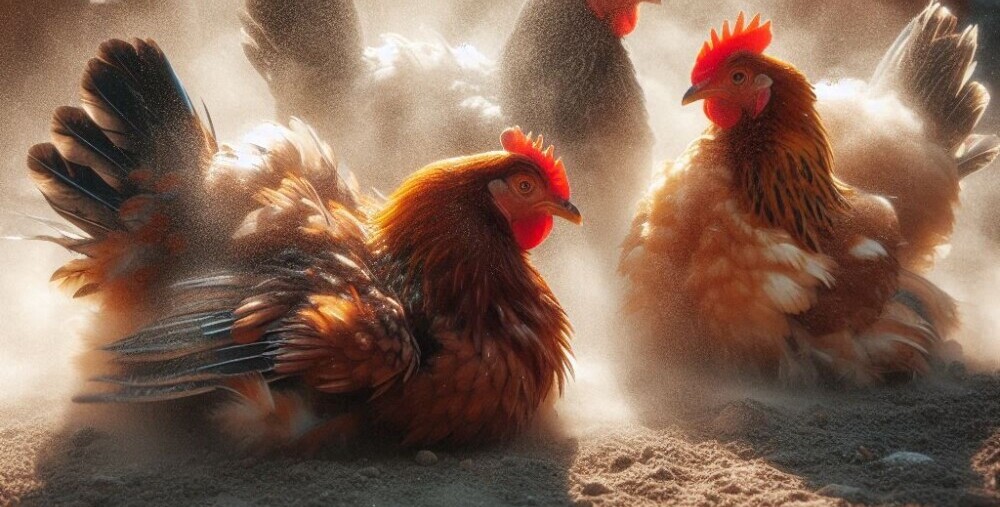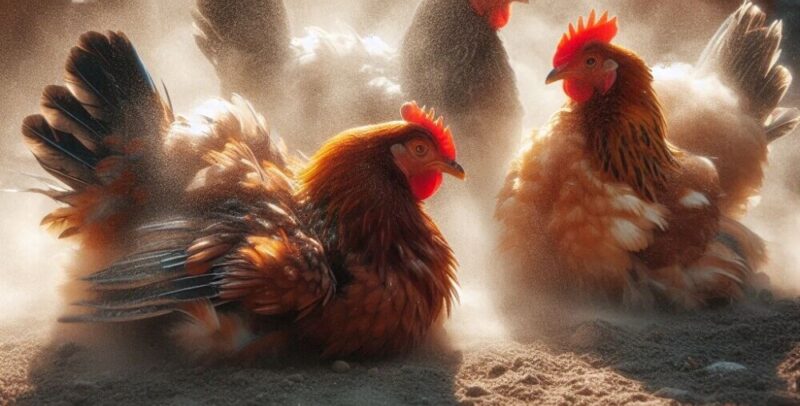
Chickens are fascinating creatures with a whole bunch of quirky habits, and dust bathing is one of their most essential behaviors. Picture your fluffy hens rolling around in loose soil, wings flapping in a flurry of dust. It might seem odd, but there’s a solid reason behind it.
Dust bathing is nature’s way of keeping chickens clean and healthy without the help of water or soap. It’s a primal ritual that promotes chicken hygiene and keeps pesky parasites like mites and lice at bay. In the wild, chickens indulge in this activity to manage skin oils, maintain their feathers, and shield themselves from uninvited pests.
But it’s not just about cleanliness. Dust bathing offers a social platform for chickens, letting them interact with their pals while they relax and unwind. These sessions are crucial for their well-being and showcase their instincts. So, providing a great dust bathing area can significantly boost your chicken’s health and happiness.
Throughout this guide, I’ll help you understand why chickens adore dust bathing and share tips on setting up the perfect dust bath area for your backyard flock. Get ready to observe your chickens in a whole new light as they flap and cluck their way to happiness!
Understanding the Mechanics of Chicken Dust Bathing
Chickens are pretty clever when it comes to keeping themselves spick and span without a drop of water. Dust bathing is their choice of spa treatment, and it’s all about kicking up dirt to tackle the task.
When a chicken flops down in the soil and churns up dust, it’s engaging in natural grooming. Dust bathing helps in the fight against parasites like mites and lice, acting as a sort of asphyxiant for these tiny pests. This is a crucial aspect of poultry care, as it allows chickens to stay clean without chemicals.
Another reason chickens are so inclined towards dust bathing is related to feather maintenance. Dust absorbs excess oils from their skin and feathers, keeping them in top condition. This oil regulation is vital for their health, as it prevents feathers from getting too greasy, which can lead to other issues.
Chickens don’t just instinctively know how to bathe the right way—they thrive on it. Watching them indulge in this behavior is a testament to how they’ve been keeping tidy long before we showed up with our fancy cleaning products. Dust bathing is an innate behavior; it’s all about grooming and keeping those feathers fluff-approved and cool!
Crafting the Optimal Dust Bath Environment
Crafting the perfect dust bath area for your chickens boils down to picking the right spot. Chickens have a knack for choosing areas that fit their needs, but with a little guidance, you can set up a dust bath that’s just right.
Chickens naturally gravitate towards dry, loose soil, often finding comfort beneath the shade of a tree or bush. This setup lets them escape direct sunlight while enjoying a nice roll in the soil. Shaded spots are ideal, as they keep the soil from drying out too fast in the sun or becoming soggy in the rain.
Next up, let’s talk materials. Your choices here can make a huge difference. Sand, fine soil, wood ash, and food-grade diatomaceous earth are popular picks, creating a fine mixture that chickens love. Steer clear of anything treated with chemicals—it’s got to be safe for your hens to roll around in.
Some people shy away from diatomaceous earth because the particles of diatoms are so small and so sharp that they can damage chickens’ lungs if inhaled. Use carefully by applying directly to fathers if you like.
When considering size, ensure your dust bath area is spacious enough for multiple chickens to use at once. They don’t need a bathing pool, just enough space to cozy up and flap to their heart’s content. About six inches deep is usually enough to do the trick.
Creating an inviting dust bath area isn’t just about maintenance—it’s making sure it fits your flock’s needs. With the right setup, you’ll have a flock that’s itch-free, well-groomed, and content as they kick up their heels—or feathers! A kiddie pool works well.
Maintaining a Clean and Effective Dust Bath
OMRI LISTED FOR ORGANIC USE: Certified by the Organic Materials Review Institute, making it suitable for use in organic farming and gardening practices. Safe when used as directed.
Keeping your chickens’ dust bath in top condition is all about regular upkeep. Just like any well-used part of your backyard, it needs attention to continue serving its purpose.
Start by refreshing the dust bath materials frequently. Over time, the dust can become packed down or scattered, losing its effectiveness. A quick shuffle with a rake or a full refresh with fresh materials every few weeks can make a world of difference.
Contamination is another thing to watch for. Chickens aren’t picky about where they do their business, and droppings can end up in the dust bath. Keep an eye out and remove any waste regularly to maintain a clean environment.
It’s also important to know when it’s time for a more significant overhaul. If the dust bath has been topped up repeatedly, but your chickens seem less interested, it might be time for a reset. Signs like wetness, an unpleasant odor, or a lack of dustiness are telltale signs that it’s replacement time.
By staying on top of maintenance, you’re providing a clean, effective area that meets your chickens’ dust bathing needs, ensuring they continue to thrive in your backyard haven.
Troubleshooting and Enhancing Dust Bathing Practices
Ever wondered why some chickens aren’t dust bathing as much as you’d expect? It might be because of overcrowding or not having the right conditions.
If you’ve noticed hesitation, check the space they have. Overcrowded areas can suppress this natural behavior, as chickens may feel too cramped to relax. Ensuring each chicken has enough personal dust bathing space can encourage them to get playful and dirty.
Extra space can also reduce any dominance issues that might arise when chickens compete for prime dust bathing spots. If your chickens free-range, of course, you needn’t worry about space. They’ll find their own.
For those thinking about store-bought dust bath mixes, weigh the pros and cons. They can be convenient, but homemade mixes using materials like sand or dirt are effective and budget-friendly.
Remember, the environment and materials make a real difference, but so does tuning into your flock’s behavior. If they’re not dust bathing, something might be off, and adjustments are your best tool in encouraging natural chicken behavior.
Take care.
Dave

Chickenmethod.com


